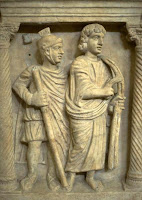
A millennium-old Byzantine mosaic of Saint John Chrysostom, Hagia Sophia
History does not repeat itself but does serve as precedent. 17th Century secularized Europe transformed Jews from religion to nation, then race. But 1700 years of Christian anti-Judaism preceded antisemitism. The Holocaust was the nearly successful final solution to Christendom’s Jewish Problem. Most Jews today limit blame to the person of Hitler. We believe our country exceptional, free of lethal antisemitism. Thus convinced we raise, no subject our children to the Precedent. This is Denial.

A millennium-old Byzantine mosaic of Saint John Chrysostom, Hagia Sophia

Arch of Titus in Rome. This detail depicts the destruction of the second Beit HaMikdash (Temple) in 70 (C.E.), Common Era; Judaism divides into Rabbinic (mostly Palestinian) and Messianic (mostly Diasporic and partly converted "God Fearers") groups.
 Mosaic: Jesus in His Glory about 400 C.E. Santa Pudernziana, Rome. In traditional Judaism a messiah is a Jew inspired by God to lead his people in times of need. The Roman Period saw a pagan power ruling the acred Land of Israel. It was a period of unrest and revolt and the Romans crucified thousands of insurectionists, several of whom either self-proclaimed or were considered by their followers to have been sent by God to eject the pagans from their holy land.
Mosaic: Jesus in His Glory about 400 C.E. Santa Pudernziana, Rome. In traditional Judaism a messiah is a Jew inspired by God to lead his people in times of need. The Roman Period saw a pagan power ruling the acred Land of Israel. It was a period of unrest and revolt and the Romans crucified thousands of insurectionists, several of whom either self-proclaimed or were considered by their followers to have been sent by God to eject the pagans from their holy land.
 Judgment of Pilate, detail of 5th [far R.] panel, mid-4th Century C.E. (probably from the Catacomb of Domitilla). Of interest here is that Pilate, represented as finding Jesus innocent, washes his hands, a Jewish tradion. During the early centuries of the seperation, in defining itself seperate from "Judaism" Christianity as the "New Israel" coopted traditional Jewish customs and rites and denied them to traditional Judaism.
Judgment of Pilate, detail of 5th [far R.] panel, mid-4th Century C.E. (probably from the Catacomb of Domitilla). Of interest here is that Pilate, represented as finding Jesus innocent, washes his hands, a Jewish tradion. During the early centuries of the seperation, in defining itself seperate from "Judaism" Christianity as the "New Israel" coopted traditional Jewish customs and rites and denied them to traditional Judaism. Christ with Roman guard before Pilate, detail of 4th [RC.] panel, mid-4th Century C.E. (probably from the Catacomb of Domitilla) The personage of Jesus emerging from the gospels is an insurectionist, capturing the Temple, the symbol of Israeli independence, and holding it for many days. As such he would have been condemned to death and crucified under Roman law. That Pilate is represented as not responsible is a reversal of historical precedent, and clearly meant to shift blame on to the Jews in an effort to appease Rome.
Christ with Roman guard before Pilate, detail of 4th [RC.] panel, mid-4th Century C.E. (probably from the Catacomb of Domitilla) The personage of Jesus emerging from the gospels is an insurectionist, capturing the Temple, the symbol of Israeli independence, and holding it for many days. As such he would have been condemned to death and crucified under Roman law. That Pilate is represented as not responsible is a reversal of historical precedent, and clearly meant to shift blame on to the Jews in an effort to appease Rome.
 Early 5th Century A.D. British Museum, London. One of four ivory panels from a casket depicting religious themes. One of the earliest known illustrations of the Crucifixion. By shifting blame for the crucifixion onto the Jews, early Christianity laid the foundation for future persecutions in the lands of Jewish dispersion.
Early 5th Century A.D. British Museum, London. One of four ivory panels from a casket depicting religious themes. One of the earliest known illustrations of the Crucifixion. By shifting blame for the crucifixion onto the Jews, early Christianity laid the foundation for future persecutions in the lands of Jewish dispersion.
